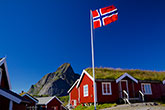Know your knots
Published by Jessica Casey,
Editor
LNG Industry,
Philippos Sfiris, Head of Hull Performance Solutions, Hempel A/S, Greece, makes the case for frictionless sailing and outlines how quality hull coatings enable steam turbine gas carriers to swap power for speed.
For around one-third of the global LNG fleet, slow steaming as an option to reduce emissions does not apply.
The approximately 240 vessels that make up the steam turbine LNG carrier fleet are the oldest and least efficient of the gas carriers. Like all LNG vessels, they use boil-off gas (BOG) from their cargoes to propel them, but this older vessel type produces the most BOG per day compared to newer designs.
Simply put, if these vessels slow steam, their voyage time is increased and the cargo is on the vessel for a longer period of time, so the ship burns more gas to complete the journey. This results in increased emissions and contradicts the overall aims of the new IMO Carbon Intensity Indicator (CII) and Energy Efficiency Existing Ship Index (EEXI) rules.
Nevertheless, like all vessels, they still are obliged to bring their emissions in line with the rules and improve their performance.
But with slow steaming an unattractive option as it increases both operating costs and emissions for steam turbine LNG carriers, these vessels have to resort to other emissions reduction options, such as propeller shaft power limitation (ShaPOLi). According to 2021 Bureau Veritas data, in order to reach required EEXI emissions levels, ShaPOLi would have to be applied by 15% to as much as 45%. This equates to a po-tential speed loss of 2 – 2.5 knots.
Moreover, since the operational speed for these vessels will be very close to their maximum speed, owners need solutions to prevent or minimise the increase in power required due to hull and propeller deterioration.
These scenarios will erode steam turbines’ commercial competitiveness and have charter party implications.
With this in mind, EEXI and CII are forcing some owners to rethink the future commercial viability of steam turbine-powered vessels. But before any big decisions are made, Hempel, a leading manufacturer of hull coatings, encourages owners to consider other options available to improve the speed/power ratio – including advanced silicone hull coating solutions.
A ship’s hull represents around 70% of its overall structure, and is thus a good place to start when considering a vessel emissions reduction programme.
One of the least intrusive and quickest ways to improve a vessel’s operational performance is with a coatings upgrade. By reducing biofouling, and in turn reducing resistance as the hull cuts through the water, less energy is required by the propeller to power the vessel.
This leads to reduced fuel consumption and emissions and, ultimately, an improved Vref (speed reference as defined in model test) and CII rating compared to conventional antifouling solutions. Some coatings upgrades offer an immediate increase in Vref following application in dry dock, such as Hempel’s Hempaguard MaX which offers a significant 2 – 3%.
Calculating a coating
As a marine coatings provider, Hempel believes that its role in shipping’s emissions reduction pathway is to act as a trusted industry advisor. Ship owners and operators often ask about the various emissions-reducing options available to help them with their CII rating and, in response, the company has created a platform that can generate a coatings impact report for any vessel in the world fleet.
These reports give ship-specific CII and EEXI analysis for any coating, and can compare and contrast between available products. It gives customers accurate data on the cost of ownership, return on investment (ROI) and CII/EEXI impact of a coating prior to investment.
The CII & EEXI Impact Analysis Tool determines the performance of a hull coat-ing by the ‘out of dock speed/power gain’ and the ‘speed loss percentage’.
It can be visualised as follows: out of dock power gain + speed loss in power = total savings percentage.
After the coating has been applied in dry dock, the ‘out of dock power gain’ is realised within the first year and shows the decrease in power (and fuel consumption) at a specific speed. ‘Speed loss percentage’ is averaged over the ship’s service period. Translating the speed loss percentage to power with a 3:1 speed-to-power relationship and adding it to the ‘out of dock power gain’ figure gives the ‘total savings percentage’ over the service period from a specific hull coating application.
Hempel recommends that two or three paint systems are analysed including the existing system already applied to the vessel, so that accurate comparisons can be drawn. Further, the company recommends that the following criteria be considered before committing to a new hull coating product or service:
- Expected impact on CII for different coating systems, surface preparation scenarios and, if needed, the Vref change for the purpose of EEXI.
- Total cost of ownership associated with the coating choice, including the cost of the coating itself, shipyard cost for surface preparation and paint application, cost of clean-ing based on the expected performance of chosen coating, fuel cost over the ship’s service life, and return on investment in months.
- Any economic benefits for the owner and operator, including fuel savings for the charter period and increase in daily earnings (time charter equivalent).
With this data-driven approach, owners can fully appreciate the impact their in-vestment will have on their vessel’s efficiency and commercial prospects.
Enjoyed what you've read so far? Read the full article and the rest of the October issue of LNG Industry by registering today for free!
Read the article online at: https://www.lngindustry.com/special-reports/20102023/know-your-knots/
You might also like
Gasum opens new biogas filling station in Norway
Gasum has opened its ninth bio-LNG station in Norway, located in Førde.

